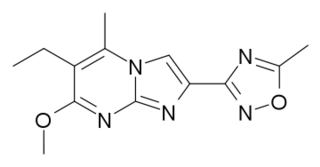Oxadiazoles are a class of heterocyclic aromatic chemical compound of the azole family; with the molecular formula C2H2N2O. There are four isomers of oxadiazole:
Azoles are a class of five-membered heterocyclic compounds containing a nitrogen atom and at least one other non-carbon atom as part of the ring. Their names originate from the Hantzsch–Widman nomenclature. The parent compounds are aromatic and have two double bonds; there are successively reduced analogs with fewer. One, and only one, lone pair of electrons from each heteroatom in the ring is part of the aromatic bonding in an azole. Names of azoles maintain the prefix upon reduction. The numbering of ring atoms in azoles starts with the heteroatom that is not part of a double bond, and then proceeds towards the other heteroatom.
In chemistry, isomers are ions or molecules with identical formulas but distinct structures. Isomers do not necessarily share similar properties. Two main forms of isomerism are structural isomerism and stereoisomerism.
- 1,2,3-oxadiazole
- 1,2,4-oxadiazole
- 1,2,5-oxadiazole
(furazan)

Furazan, or 1,2,5-oxadiazole, is a heterocyclic aromatic organic compound consisting of a five-atom ring containing 1 oxygen and 2 nitrogen atoms. The furazan ring system is also found in the steroid furazabol. Furazan and its derivatives are obtained from the oxime derivatives of 1,2-diketones.

1,3,4-Oxadiazole is a nitrogen and oxygen containing heterocycle, and one of the four isomers of oxadiazole.
1,2,4-Oxadiazole, 1,2,5-oxadiazole, and 1,3,4-oxadiazole are all known and appear in a variety of pharmaceutical drugs including raltegravir, butalamine, fasiplon, oxolamine, and pleconaril. The 1,2,3-isomer is unstable and ring-opens to form the diazo ketone tautomer; [1] however, it does exist within the unusual sydnone motif.

Raltegravir (RAL), sold under the brand name Isentress, is an antiretroviral medication used, together with other medication, to treat HIV/AIDS. It may also be used, as part of post exposure prophylaxis, to prevent HIV infection following potential exposure. It is taken by mouth.

Butalamine is a vasodilator.

Fasiplon is a nonbenzodiazepine anxiolytic drug from the imidazopyrimidine family of drugs.
In 2018, a compound called bis(1,2,4-oxadiazole)bis(methylene) dinitrate which might have a 1.5 times the power of TNT was developed at the United States Army Research Laboratory (ARL) working with the Los Alamos National Laboratory. [2]

Bis-oxadiazole, or more formally known as bis(1,2,4-oxadiazole)bis(methylene) dinitrate, is a nitrated heterocyclic compound of the oxadiazole family.

Trinitrotoluene (; TNT), or more specifically 2,4,6-Trinitrotoluene, is a chemical compound with the formula C6H2(NO2)3CH3. This yellow solid is sometimes used as a reagent in chemical synthesis, but it is best known as an explosive material with convenient handling properties. The explosive yield of TNT is considered to be the standard measure of bombs and the power of explosives. In chemistry, TNT is used to generate charge transfer salts.

The Army Research Laboratory (ARL) is the U.S. Army's corporate research laboratory. ARL is headquartered at the Adelphi Laboratory Center (ALC) in Adelphi, Maryland. Its largest single site is at Aberdeen Proving Ground, Maryland. Other major ARL locations include Research Triangle Park, North Carolina, White Sands Missile Range, New Mexico, Orlando, Florida, and NASA's Glenn Research Center, Ohio and Langley Research Center, Virginia.














